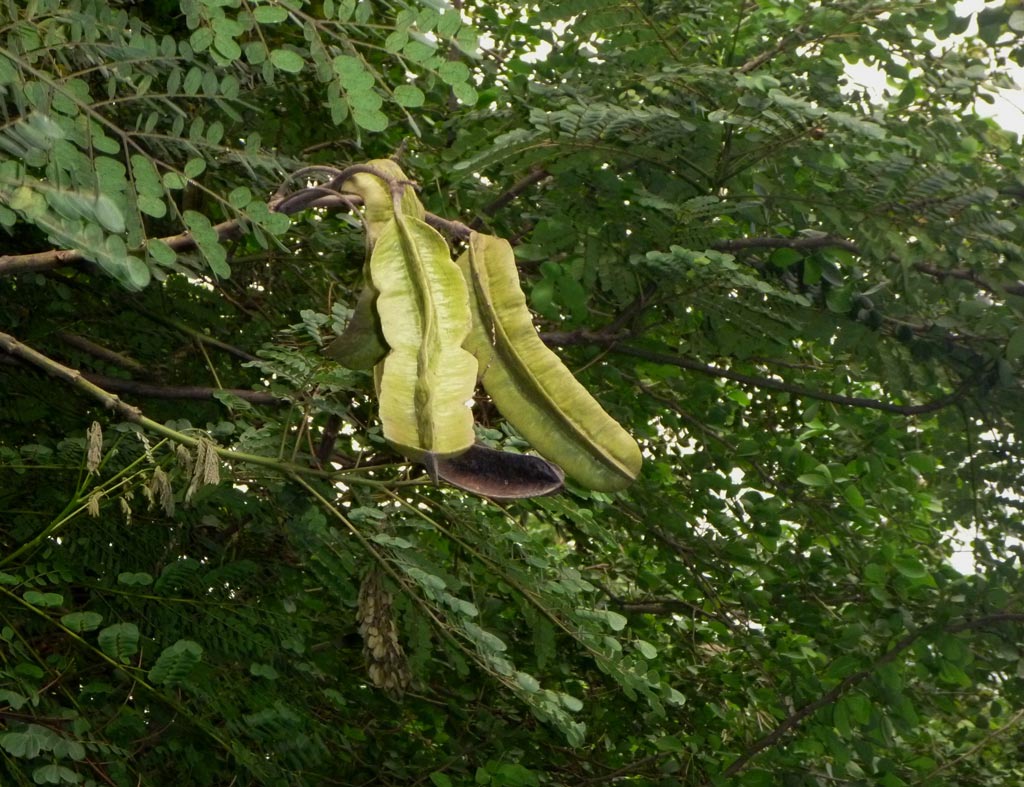Tetrapleura tetraptera

|
|
Tetrapleura tetraptera Common Names: Aidan Tree, Prekese, Gum Tree, African
Spice Scientific
Classification Kingdom: Plantae Phylum: Tracheophyta Class: Magnoliopsida Order: Fabales Family: Fabaceae Genus: Tetrapleura Species: T. tetraptera Synonyms: Adenanthera tetraptera Schumacher & Thonning, Entada tetraptera (Schumacher & Thonning) Roberty Morphological Description Tetrapleura tetraptera, commonly known as the Aidan Tree or Prekese, is a deciduous tree
growing 15–25 m tall, occasionally reaching 30 m. Its key features include: · Bark: Grey-brown, smooth to fissured, with a reddish, scented
slash · Leaves: Bipinnately compound, 15–30 cm long, with 5–9 pinnae, each
bearing 12–24 elliptic leaflets, 1–2 cm long · Flowers: Pinkish-cream to orange-brown, 3–5 mm long, in spike-like
racemes 5–20 cm long, blooming during the rainy season · Fruit: Dark brown to black pod, 12–25 cm long, 3.5–6.5 cm wide,
with four wing-like ridges (two woody, two fleshy with edible pulp) The fruit’s pungent,
aromatic odor is a hallmark, used as a spice and insect repellent (Fern, 2024). Distribution and Habitat Tetrapleura tetraptera is native to tropical Africa, from Senegal and Ghana to
Sudan, Kenya, and Tanzania, extending south to Angola. It thrives in: · Ecosystems: Rainforests, secondary forests, forest edges, and savanna
woodlands · Climate: Tropical, with rainfall of 1,200–3,000 mm annually and
temperatures of 20–35°C · Soils: Well-drained, loamy to sandy, often nutrient-rich · Altitude: 0–1,400 m Ethnopharmacology Tetrapleura tetraptera is a medicinal plant extensively used in traditional African
medicine for its wide range of therapeutic benefits. The fruits, bark, and
leaves are particularly valued for their anti-inflammatory, antimicrobial,
antioxidant, antidiabetic, and antihypertensive properties. Traditionally, the
fruit is boiled and consumed to treat fevers, convulsions, malaria,
gastrointestinal disorders, and postpartum care. Scientific studies have
confirmed that extracts from the plant possess strong free radical scavenging
activity, support glucose regulation, and exhibit analgesic and antimicrobial
effects against a variety of pathogens. Phytochemical investigations have
identified compounds such as flavonoids, tannins, saponins, alkaloids, and
phenols, which contribute to its pharmacological effects. The fruit is also
used as a culinary spice in many West African dishes, which enhances its
acceptability as a medicinal food. Generally regarded as safe in traditional
use, further clinical studies are recommended to validate and standardize its
therapeutic applications. · Anti-inflammatory Effects: In Nigeria, aqueous fruit extracts reduced
paw edema in rats by 45% at 200 mg/kg, attributed to flavonoids and tannins,
supporting its use for arthritis (Ojewole, 2004). · Hypoglycaemic Properties: Its use for type-2 diabetes. · Analgesic Activity: Fruit extracts delayed pain response in
mice by 50% at 400 mg/kg, confirming its use for pain relief (Aderibigbe et
al., 2007). · Anticonvulsant Activity: Aqueous fruit extracts delayed
pentylenetetrazole-induced seizures in mice by 30% at 800 mg/kg, supporting its
use for epilepsy and convulsions (Aderibigbe et al., 2007). · Antimicrobial Activity: Ethanolic extracts of T. tetraptera pods
have demonstrated significant inhibitory effects against pathogens such as
Escherichia coli, Staphylococcus aureus, Pseudomonas spp., and Proteus spp.,
with inhibition zones ranging from 11.33 mm to 13.33 mm. The efficacy was
observed to be higher in ethanolic extracts compared to aqueous and acetone
extracts, indicating the influence of solvent polarity on phytochemical
extraction. The antibacterial
activity of T. tetraptera is attributed to its ability to disrupt bacterial
metabolic pathways. Specifically, the extracts interfere with the
Embden–Meyerhof–Parnas and hexose monophosphate pathways, leading to inhibited
growth of E. coli and S. aureus (Enaregha et al., 2021). · Antimalarial Activity: Methanolic bark extracts inhibited Plasmodium falciparum (IC₅₀ 10–50 µg/mL), supporting its use for
malaria (Lekana-Douki et al., 2011). · Antioxidant Activity: Indicating potential to reduce oxidative
stress (Mongalo et al., 2015). ⚠ Toxicity Profile: Acute toxicity studies indicate a high LD₅₀
(>5,000 mg/kg) for fruit extracts in rats, suggesting low acute toxicity.
Sub-chronic high doses (>1,000 mg/kg) may alter renal function, causing
elevated creatinine levels, necessitating caution with long-term use. Haematological
studies showed reduced red and white blood cell counts at 50 mg/kg ethanolic
extract in rabbits, indicating potential haemolytic effects at high doses
(Odesanmi et al., 2010). Additional Uses · Culinary: The fruit’s fleshy pulp is used as a spice in soups (e.g.,
palm nut soup, banga), valued for its sweet fragrance (Fern, 2024). · Industrial: Bark tannins are used for dyeing, and fruit extracts serve
as natural preservatives due to their antimicrobial properties. · Ecological: Provides shade and supports pollinators; pods attract birds
and mammals, aiding seed dispersal (Clayton et al., 2016). · Economic: Fruit sales contribute to rural incomes in Nigeria and
Ghana, supporting food security and poverty reduction (Burkill, 1995). References
External Links More Pictures |
|
| Compounds of Tetrapleura tetraptera |
|
| References |